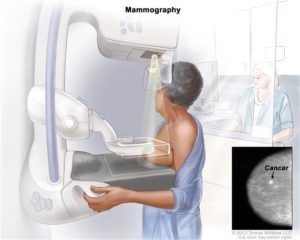
Diagnosed with Cancer? Your two greatest challenges are understanding cancer and understanding possible side effects from chemo and radiation. Knowledge is Power!
Learn about conventional, complementary, and integrative therapies.
Dealing with treatment side effects? Learn about evidence-based therapies to alleviate your symptoms.
Click the orange button to the right to learn more.
Long-Term Breast Cancer Survival Enhanced W/ Lymph-nodes?
Preservation of healthy lymph nodes may have beneficial consequences. Axillary dissection should not be performed in breast cancer patients without first examining the sentinel node.”
(Ed. Note- See the update below)
I believe this article might be one of many that lead to the new guidelines discussed in the article I wrote about earlier, “NCCN Breast Cancer Guidelines Updated: SLNB and PET/CT Are Highlights
“Yes, I do understand it and applaud the researchers for doing it. The first article says that Sentinel Node Biopsy should now be the standard of care for stage I and II breast cancers. I think the new standards are a few years behind their time, but they needed a ten-year look-back to be certain of their findings. It seems to be a case of the research catching up with something that had become fairly obvious. I believe most doctors “in the know” were already routinely performing Sentinel Node Biopsies. I think I covered this a bit in my reply about the new guidelines about SNLB.
To help you understand it the following is a basic description of the SNLB.
A sentinel lymph node (SLN) is the first lymph node (sometimes there is more than one) to which cancer cells might spread from the primary tumor. Doing the SNLB can avoid the more extensive axillary lymph node dissection which surgically removed all level I and level II lymph nodes in the axillary area which is generally in the underarm area. If there is no cancer in the sentinel node the cancer isn’t likely to have spread and the additional lymph nodes can be spared. If cancer is found in the sentinel node then it is usually necessary to perform an axillary lymph node dissection to remove the rest of the nodes to see how far cancer might have spread.
The researchers conclusion is that “the long-term breast cancer-related event-free survival in the (sentinel node-based dissection) arm was similar to that in the (routine dissection) arm, enabling us to affirm not only that sentinel node biopsy is as good as complete axillary dissection at staging the axilla, but that it is as safe as the once standard method of complete axillary dissection.”
This is wonderful because many women will be able to avoid the unnecessary removal of many valuable lymph nodes and avoid the complication of life-long lymphedema. Also, the sentinel node biopsy avoids many of the surgical complications involved with full dissection.
The SNLB is far less risky and the risk of lymphedema is much reduced with this procedure.
On a personal note, because I had the sentinel node biopsy and it was negative for cancer, I am delighted to see these results. There were early and promising results at the time, but a ten-year study is very affirming.
Mary Miller- BC Profile in Courage-
Recommended Reading:
- Breast Cancer-Prevent Radiation-Induced Dermatitis- Ugly, Painful Side Effect
- Prevent Chemo-Induced Heart Damage in Breast Cancer
- Why Breast Cancer Research Can’t Be Trusted
Sentinel lymph node biopsy in breast cancer: ten-year results of a randomized controlled study.
“Conclusion-Preservation of healthy lymph nodes may have beneficial consequences. Axillary dissection should not be performed in breast cancer patients without first examining the sentinel node.”
Breast Cancer Chemo Responders May Avoid Lymph Node Surgery
“Lymph node surgery to check for the spread of breast cancer could be avoided even in women with aggressive cancers if they respond well to initial chemotherapy, suggest the results of two new studies.
The findings, presented at the 11th European Breast Cancer Conference, suggest that some women with triple-negative or HER2+ disease could therefore avoid axillary surgery and its associated adverse affects.
“Whether or not a breast cancer has spread to nearby lymph nodes is a key indicator of a patient’s prognosis,” commented Robert Mansel, MD, chair of the conference and professor emeritus of surgery at Cardiff University School of Medicine, United Kingdom.
“That’s why sentinel lymph node biopsy has been an important part of treating breast cancer,” he continued…
However, the procedure is associated with ongoing adverse effects in some women, such as swelling, numbness, and reduced movement of the arm
“These two studies give us clues on which patients have a very low risk of cancer in their lymph nodes after chemotherapy. This could enable us to reduce unnecessary surgery when it’s safe to do so, helping us tailor treatments towards individual patients,” Mansel commented in a statement…”


